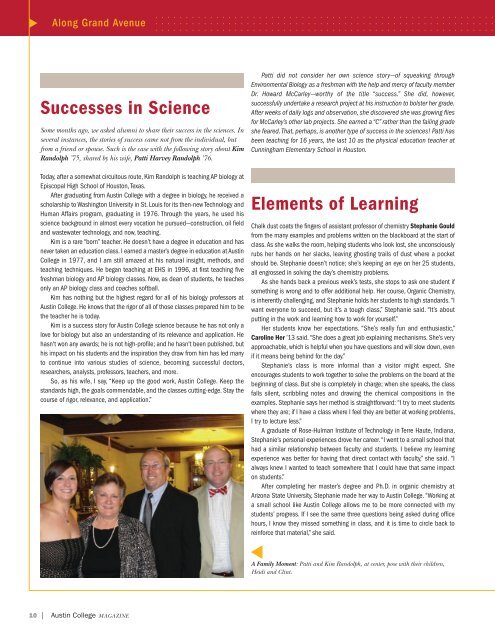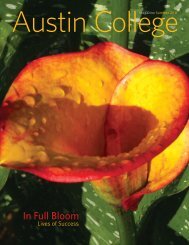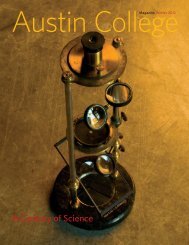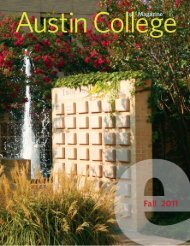Magazine Fall/Winter 2012 - Austin College Magazine
Magazine Fall/Winter 2012 - Austin College Magazine
Magazine Fall/Winter 2012 - Austin College Magazine
Create successful ePaper yourself
Turn your PDF publications into a flip-book with our unique Google optimized e-Paper software.
▲Along Grand Avenue. . . . . . . . . . . . . . . . . . . . . . . . . . . . . . . . . . . . . . . . . . . . . . . . . . . . . . . .. . . . . . . . . . . . . . . . . . . . . . . . . . . . . . . . . . . . . . . . . . . . . . . . . . . . . . . .. . . . . . . . . . . . . . . . . . . . . . . . . . . . . . . . . . . . . . . . . . . . . . . . . . . . . . . .Successes in ScienceSome months ago, we asked alumni to share their success in the sciences. Inseveral instances, the stories of success came not from the individual, butfrom a friend or spouse. Such is the case with the following story about KimRandolph ’75, shared by his wife, Patti Harvey Randolph ’76.Today, after a somewhat circuitous route, Kim Randolph is teaching AP biology atEpiscopal High School of Houston, Texas.After graduating from <strong>Austin</strong> <strong>College</strong> with a degree in biology, he received ascholarship to Washington University in St. Louis for its then-new Technology andHuman Affairs program, graduating in 1976. Through the years, he used hisscience background in almost every vocation he pursued—construction, oil fieldand wastewater technology, and now, teaching.Kim is a rare “born” teacher. He doesn’t have a degree in education and hasnever taken an education class. I earned a master’s degree in education at <strong>Austin</strong><strong>College</strong> in 1977, and I am still amazed at his natural insight, methods, andteaching techniques. He began teaching at EHS in 1996, at first teaching fivefreshman biology and AP biology classes. Now, as dean of students, he teachesonly an AP biology class and coaches softball.Kim has nothing but the highest regard for all of his biology professors at<strong>Austin</strong> <strong>College</strong>. He knows that the rigor of all of those classes prepared him to bethe teacher he is today.Kim is a success story for <strong>Austin</strong> <strong>College</strong> science because he has not only alove for biology but also an understanding of its relevance and application. Hehasn't won any awards; he is not high-profile; and he hasn't been published, buthis impact on his students and the inspiration they draw from him has led manyto continue into various studies of science, becoming successful doctors,researchers, analysts, professors, teachers, and more.So, as his wife, I say, “Keep up the good work, <strong>Austin</strong> <strong>College</strong>. Keep thestandards high, the goals commendable, and the classes cutting-edge. Stay thecourse of rigor, relevance, and application.”Patti did not consider her own science story—of squeaking throughEnvironmental Biology as a freshman with the help and mercy of faculty memberDr. Howard McCarley—worthy of the title “success.” She did, however,successfully undertake a research project at his instruction to bolster her grade.After weeks of daily logs and observation, she discovered she was growing fliesfor McCarley’s other lab projects. She earned a “C” rather than the failing gradeshe feared.That, perhaps, is another type of success in the sciences! Patti hasbeen teaching for 16 years, the last 10 as the physical education teacher atCunningham Elementary School in Houston.Elements of LearningChalk dust coats the fingers of assistant professor of chemistry Stephanie Gouldfrom the many examples and problems written on the blackboard at the start ofclass.As she walks the room, helping students who look lost, she unconsciouslyrubs her hands on her slacks, leaving ghosting trails of dust where a pocketshould be. Stephanie doesn’t notice; she’s keeping an eye on her 25 students,all engrossed in solving the day’s chemistry problems.As she hands back a previous week’s tests, she stops to ask one student ifsomething is wrong and to offer additional help. Her course, Organic Chemistry,is inherently challenging, and Stephanie holds her students to high standards.“Iwant everyone to succeed, but it’s a tough class,” Stephanie said. “It’s aboutputting in the work and learning how to work for yourself.”Her students know her expectations. “She’s really fun and enthusiastic,”Caroline Her ’13 said.“She does a great job explaining mechanisms. She’s veryapproachable, which is helpful when you have questions and will slow down, evenif it means being behind for the day.”Stephanie’s class is more informal than a visitor might expect. Sheencourages students to work together to solve the problems on the board at thebeginning of class. But she is completely in charge; when she speaks, the classfalls silent, scribbling notes and drawing the chemical compositions in theexamples. Stephanie says her method is straightforward: “I try to meet studentswhere they are; if I have a class where I feel they are better at working problems,I try to lecture less.”A graduate of Rose-Hulman Institute of Technology in Terre Haute, Indiana,Stephanie’s personal experiences drove her career.“I went to a small school thathad a similar relationship between faculty and students. I believe my learningexperience was better for having that direct contact with faculty,” she said. “Ialways knew I wanted to teach somewhere that I could have that same impacton students.”After completing her master’s degree and Ph.D. in organic chemistry atArizona State University, Stephanie made her way to <strong>Austin</strong> <strong>College</strong>. “Working ata small school like <strong>Austin</strong> <strong>College</strong> allows me to be more connected with mystudents’ progress. If I see the same three questions being asked during officehours, I know they missed something in class, and it is time to circle back toreinforce that material,” she said.▲A Family Moment: Patti and Kim Randolph, at center, pose with their children,Heidi and Clint.10 | <strong>Austin</strong> <strong>College</strong> MAGAZINE





